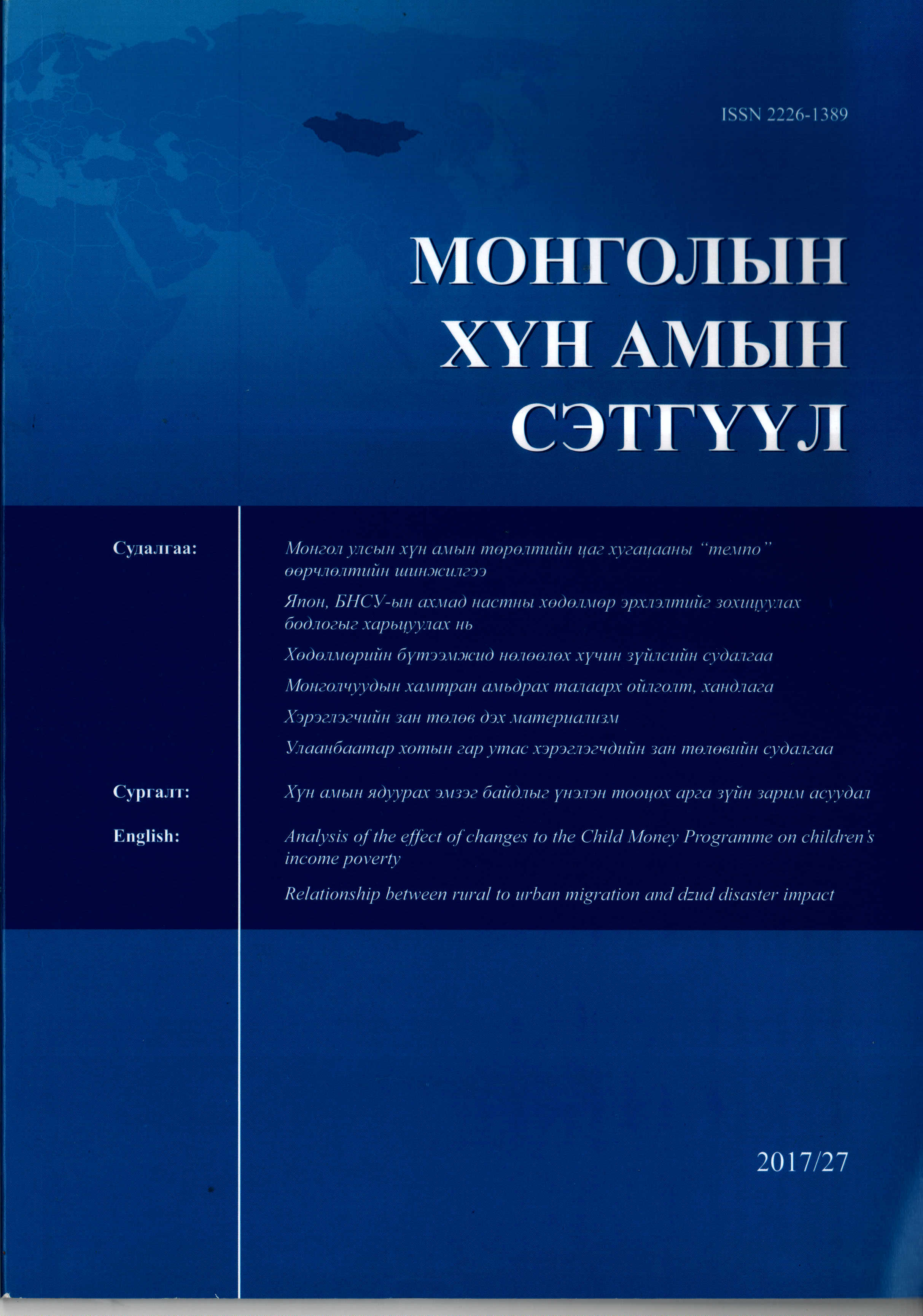Япон, БНСУ-ын ахмад настны хөдөлмөр эрхлэлтийг зохицуулах бодлогыг харьцуулах нь
Main Article Content
Abstract
Япон, БНСУ-ын засгийн газраас хүн амын насжилт, ахмад настнуудын хөдөлмөр эрхлэлтэнд ихээхэн ач холбогдол өгч, төрийн бодлогоор дэмжин зохицуулж байна. Энэ орнуудын засгийн газраас ахмад настанг хөдөлмөр эрхлүүлэх талаарх аж ахуйн нэгжийн үүргийг хуулиар баталгаажуулсан цогц бодлогуудыг боловсруулж, боловсронгуй болгосоор байна. Япон, БНСУ нь ахмад настнуудын хөдөлмөр эрхлэлтийг дэмжихийн тулд тэтгэврийн насыг сунгах, тэтгэвэрт гарах насанд зохицуулалт хийх байдлаар бодлого хэрэгжүүлж байна. Мөн эдгээр орнууд өөрсдийн нийгэм, эдийн засгийн хөгжилд тохирох ахмад настнуудын ажил эрхлэлтийн бодлогыг боловсруулахдаа энэ талаарх судалгаа, тайланд ихээхэн ач холбогдол өгч байна. Япон, Солонгост ахмад настны хөдөлмөр эрхлэлтийг засгийн газрын хөтөлбөр болгон хэрэгжүүлсэнээр ахмад хүмүүсийн хөдөлмөр эрхлэлтийг дэмжиж, нийгмийн тэтгэвэрийн дарамтыг бууруулж, эдийн засгийн тогтвортой өсөлтийг хангах ажиллах хүчний нөөцийг бий болгож чаджээ. Япон, БНСУ-ын хувьд засгийн газар, нийгэм, ард иргэд болон хувь хүмүүс нь хүн амын насжилт, мөн ахмад настнуудын хөдөлмөр эрхлэлтийн талаар гүнзгий ойлголттой болж, өмнөхөөсөө илүү идэвхтэй байдлаар хүлээн авч, ахмад настнуудын ажил эрхлэлтэнд эерэгээр хандах болж, хүн амын насжилт, ахмад настнуудын хөдөлмөр эрхлэлтийн асуудлыг шийдэх тал дээр нилээд ололттой байгаа юм. Иймд энэ 2 орны авч хэрэгжүүлж буй бодлогыг судлахыг зорилоо.
The impact of population aging on our lives has been increasing in importance. In countries that have high levels of aging problems, the population aging is shown itself in the forms of scarcity of labor force and older labor force. Moreover, in those societies, the social pension funds eventually become unsustainable. Therefore,it is of significant importance and beneficial for us that we study how other countries are addressing their population aging problems.
Japan and the Republic of South Korea are among the countries that have been experiencing fast population aging problems. As a result, both countries pay especial attention to their populations` aging and the employment of their elderly labor forces. They try to regulate their problems with government policies. For instance, in both countries, comprehensive government policies keep being initiated and implemented and the employment of elderly labor force has been already made a part of employment obligations of corporations in the Corporate Employment Laws and retirement ages have gone up in support of elderly employment. In addition, the governments place significant focus on academic researches and studies conducted in the fields and take decisions based on those researches and studies when they design and launch any program and policy targeting aging problems. Due to the successful implementation of the employment of the elderly labor force as government programs, there is now an elderly working class in Japan and the Republic of South Korea that helps reduce pressures on the public pension funds and also helps create sustainable economic growth. And both countries have reached an advanced degree in terms of the awareness and understanding, of population aging problems and the employment of elderly labor force at all levels of society and hence, the employment of the elderly has begun to be perceived as a positive incident and supported widely. Today, Japan and the Republic of South Korea have both advanced in their endeavor of solving the employment of their elderly population. This study looks at the present state and the future trend, of population aging in Japan and the Republic of South Korea, the causes and the effects, of population aging on the employment of the elderly, in the countries, and then analyzes and compares the individual government policies addressing the employment of the elderly.
